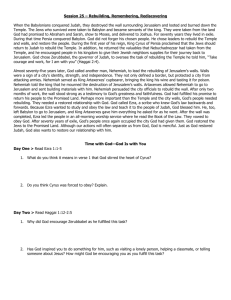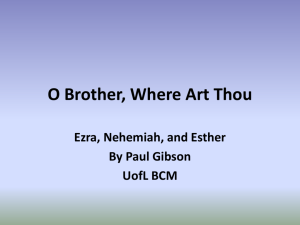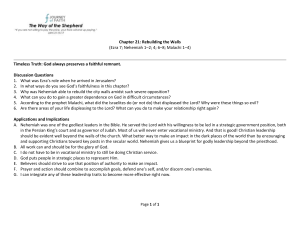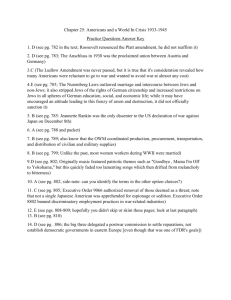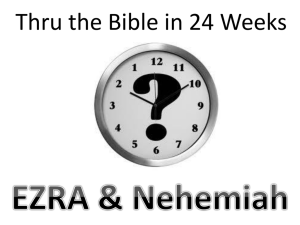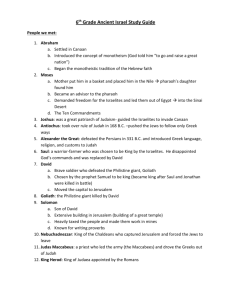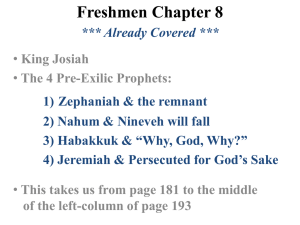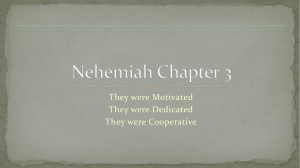Introduction to Ezra, Nehemiah and Esther
advertisement
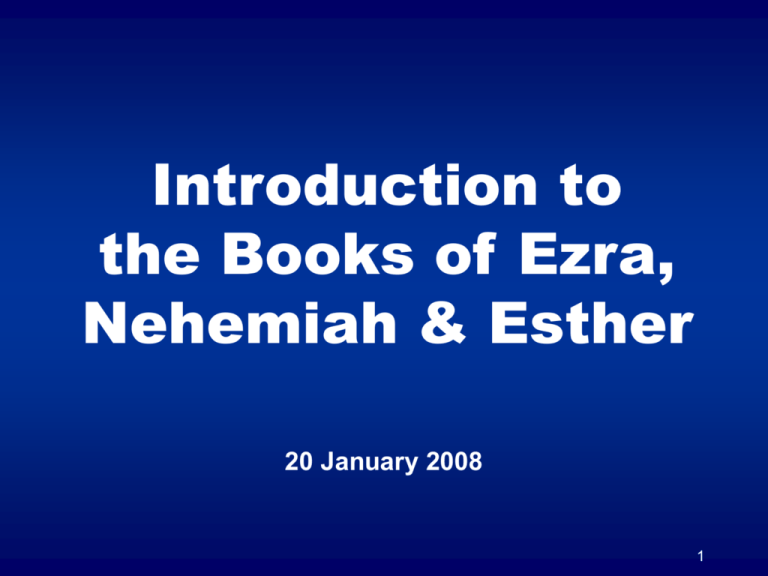
Introduction to the Books of Ezra, Nehemiah & Esther 20 January 2008 1 Prophecy of Captivity But it shall come to pass, if you do not obey the voice of the LORD your God, to observe carefully all His commandments …The LORD will bring you and the king whom you set over you to a nation which neither you nor your fathers have known, … the LORD will rejoice over you to destroy you and bring you to nothing; and you shall be plucked from off the land … Then the LORD will scatter you among all peoples. – Dt. 28:15,36, 63,64 NKJV, 1423 B.C. 2 Prophecy of Restoration Now it shall come to pass, when all these things come upon you … and you return to the LORD your God and obey His voice … that the LORD will bring you back from captivity, and have compassion on you, and gather you again from all the nations where the LORD your God has scattered you. – Dt. 30:1-3 NKJV, 1423 B.C. 3 Prophecy of Restoration For thus says the LORD: After seventy years are completed at Babylon, I will visit you and perform My good word toward you, and cause you to return to this place. For I know the thoughts that I think toward you, says the LORD, thoughts of peace and not of evil, to give you a future and a hope. – Jer 29:10,11 NKJV, 597 B.C. 4 Overview of the 3 Books Ezra 1-6 Nehemiah Esther Ezra 7-10 Restoration under Zerubbabel Reformation under Ezra Reconstruction under Nehemiah 538-515 B.C. 457 B.C. 444-425 B.C Temple Prophets: Haggai & Zechariah 1st return (about 50,000 or 2%) 58 year gap People – 2nd return (about 2,000) 13 year gap Walls Prophet: Malachi 3rd return 5 Persian Kings in the 3 Books 559-530 B.C. Cyrus “the Great” 530-522 B.C. Cambyses (also called Ezra 1-6 Artaxerxes or Ahasuerus) 522 B.C. Smerdis (not mentioned) 521-486 B.C. Darius I “the Great” Esther 486-464 B.C. Ahasuerus (also called Xerxes) (Esther’s husband) Ezra 7-10 & 464-423 B.C. Artaxerxes I (Esther’s stepson, Ezra’s supporter Nehemiah & Nehemiah’s boss) 423-404 B.C. Darius II (briefly mentioned in Neh.12:22) 6 Key People in the 3 Books Place Years Good Guys Bad Guys Jerusalem 538-515 B.C. Joshua Zerubbabel Samaritans Shushan (or Susa), Persia 483-473 B.C. Mordecai Esther Ahasuerus Haman Jerusalem 457-425 B.C. Ezra Nehemiah Sanballat Tobiah 7 Joshua High priest Worked with Zerubbabel to Lead people to Jerusalem Build the altar Restore worship Build 2nd temple 8 Zerubbabel Grandson of Jehoiachin, once King of Judah (Mt. 1:12) 18th great grandfather of Jesus With Joshua, he led the 1st group of Jews (about 50,000 out of 2 or 3 million) 900 miles from Persia to Jerusalem in 536 B.C. With Joshua, built the altar and the 2nd temple 9 Zerubbabel Moreover the word of the LORD came to me, saying: “The hands of Zerubbabel have laid the foundation of this temple; His hands shall also finish it. Then you will know that the LORD of hosts has sent Me to you.” (Zechariah 4:8,9 NKJV) 10 Samaritans Lived in Samaria, the area developed by the Northern Kingdom of Israel Were either descended from the Assyrian or Babylonian peoples brought to the area by King Esarhaddon of Assyria after the fall of Samaria or were mestizos born from these people and some Israelis who had remained in the land (See 2 Kings 17:24-41 & Ezra 4:2) Feared and served the Lord a little, but served their own idols and did not obey the Mosaic Law 11 Samaritans When Joshua and Zerubbabel came, they made proposals for co-operation in the work Were rejected, though, by Zerubbabel and the elders, since they served different gods Immediately tried to discourage the Jews, spread evil reports about them and “frustrate their purpose” Wrote an evil report to King Artaxerxes (also called Cambyses or Ahasuerus), and thus stopped the work on the 2nd temple 12 Mordecai Raised his young cousin Esther Advised Esther Would not bow to Haman Later advised the king 13 Esther Orphan girl, raised by her cousin Mordecai Became queen of Persia Risked her life to save her people 14 Ahasuerus Also called Xerxes Son of Darius the Great Banished his first wife, Vashti, for disobedience Historians say he fought many battles with the Greeks 15 Haman Was the king's highest official Insisted that the king's servants bow to him Got angry when Mordecai didn't bow to him Made a plot to kill all the Jews of ancient Persia Had his plot foiled by Queen Esther Got hanged with his 10 sons from the gallows he had originally ordered built to hang Mordecai 16 Ezra His name perhaps meant “Jehovah helps” Priestly descendent of Aaron Scribe, compiler Godly man & leader Led 2nd group of Jews to Jerusalem in 457 B.C. (81 years after 1st group) 17 Ezra “Ezra had devoted himself to the study and observance of the Law of the LORD, and to teaching its decrees and laws in Israel” (7:10 NIV). Led spiritual reform in Jerusalem 18 Nehemiah His name meant “comfort of Jehovah” Served as cup-bearer of Persian King Artaxerxes during his 41-year reign Gave up the luxury of ease of the palace to help his people in Israel 19 Nehemiah Led the 3rd group of people to Jerusalem in 444 B.C. (13 years after the 2nd group) Supervised the construction of the wall to protect the city of Jerusalem Governor of Judah 20 Sanballat & Tobiah Prominent Samaritans Persistent and serious enemies to Nehemiah and the Jews during the time of the Jews' rebuilding of the wall of Jerusalem Tried morale-damaging mockery Plotted an attack that was aborted due to the Jews heavily arming themselves while they worked 21 Sanballat & Tobiah Plotted to assassinate Nehemiah, but failed Sanballat even tried to get The Lord to again devastate the people of Judah through the marriage of his daughter to a son of the high priest, in an apparent attempt to, once again, corrupt the religious practices of the Jews, but that too was successfully countered by Nehemiah. 22 The Book of Ezra Continues the narrative of 2 Chronicles About a remnant of people who return to Judah (about 2% of all those exiled) Author unknown, but probably Ezra himself Theme: spiritual, moral and social restoration of the returned remnant 23 The Book of Ezra Ch. 1-6 – Restoration of the Temple (538-516 B.C.; 22 years) Ch. 1,2 – First return to Jerusalem (49,897) Ch. 3-6 – Construction of the Temple Ch. 7-10 – Reformation of the People (458-457 B.C.; 1 year) Ch. 7,8 – Second return to Jerusalem (1,754) Ch. 9,10 – Restoration of the People 24 The Book of Nehemiah About the third and last return of Jews to Jerusalem after the Babylonian exile. So the wall was finished … in fifty-two days. And it happened, when all our enemies heard of it, and all the nations around us saw these things, that they were very disheartened in their own eyes; for they perceived that this work was done by our God. (Neh. 6:15,16 NKJV) 25 The Book of Nehemiah In this book everything is restored – temple, city wall, covenant, people – except the king Daniel 9:24-27 explains that 490 years more were required to bring in the Millennial Kingdom, when Jesus rules as king. 483 years from Artaxerxes’ decree to build the walls until the Messiah was cut off 7 more years in the near future for the Great Tribulation 26 The Book of Nehemiah Ch. 1-7 – Reconstruction of the Wall (Political focus) Ch. 1,2 – Preparation to reconstruct the wall Ch. 3-7 – Reconstruction of the wall Ch. 7-10 – Restoration of the People (Spiritual focus) Ch. 8-10 – Renewal of the Covenant Ch. 11-13 – Obedience to the Covenant 27 The Book of Esther Deals with the preservation of God’s chosen people through an unlikely servant, Esther. Unusual book in that no form of the name of God is used, nor is there any mention of the Law. The silence was intentional to illustrate the hidden but providential care of God in spite of outward appearances. 28 The Book of Esther “For if you remain completely silent at this time, relief and deliverance will arise for the Jews from another place, but you and your father’s house will perish. Yet who know whether you have come to the kingdom for such a time as this? – Esther 4:14 NKJV And in every province and city, wherever the king’s command and decree came, the Jews had joy and gladness, a feast and a holiday. Then many of the people of the land became Jews, because fear of the jews fell upon them. – Esther 8:17 NKJV 29 The Book of Esther Ch. 1-4 – Threat to the Jews 1:1 – 2:20 – Selection of Esther as Queen 2:21 – 4:17 – Formulation of the Plot by Haman Ch. 5-10 – Triumph of the Jews 5:1 – 8:3 – Triumph of Mordecai over Haman 8:8 – 10:3 – Triumph of Israel over Her Enemies 30 Israel, Assyria and Babylonia 31 World Superpowers Assyrians – 750-612 B.C. Babylonians – 612-539 B.C. Persians – 539-333 B.C. 32 Deportations 721 Assyrians took Israelis to Assyria (2 Ki. 18:11) 713 Assyrians took Jews to Assyria (2 Ki. 18:13) 605 Babylonians took Jews to Babylon (Dan. 1:1-6) 598 Babylonians took Jews to Babylon (Jer. 52:28) 597 Babylonians took Jews to Babylon (2 Ki. 24:14) 588 Babylonians took Jews to Babylon (Jer. 52:29) 586 Babylonians took Jews to Babylon (2 Ki. 25:11) 582 Babylonians took Jews to Babylon (Jer. 52:30) 33 Captivity & Exile 721 King Hoshea of Assyria captured Samaria, the capital of the Northern Kingdom, and carried Israelis away to Assyria. 713 King Sennacherib of Assyria captured many walled cities of Judah and probably carried thousands of Jews away to Assyria 34 Captivity & Exile 612 The Babylonians destroyed Nineveh, the Assyrian capital, and thus became the new world superpower. 605 King Nebuchadnezzar of Babylon captured Jerusalem and deported some good-looking and intelligent young Jewish men to Babylon, including some of the king’s descendents and some of the nobles. Daniel, Hananiah, Mishael and Azariah were among them. 35 Captivity & Exile 598 2nd deportation to Babylon (3,023 captives) 597 3rd deportation to Babylon (10,000 captives, probably including Ezekiel); only the poorest people were left in the land 588 4th deportation to Babylon (832 captives) 36 Captivity & Exile 586 Babylon plundered and destroyed Jerusalem, including the temple and walls. 5th deportation to Babylon (the remnant of the multitude); only the poor of the land were left, but they fled to Egypt with Jeremiah after Ishmael murdered Gedaliah 582 6th deportation to Babylon (745 captives) 37 Return & Restoration 539 The Persians and the Medes, under the leadership of Cyrus the Great captured Babylon. Persia became the new world superpower 538 Cyrus challenged all God’s people (Jews and Israelis) to return to Jerusalem and build a 2nd temple for God. 38 Return & Restoration 536 1st group (49,897) returned from captivity under Zerubbabel. They restored the altar and worship. 535 Builders laid foundation of the 2nd temple 529 Cyrus died and his son Artaxerxes (also called Cambyses or Ahasuerus) took over The Samaritans wrote a slanderous letter to Artaxerxes, who stopped the work. 39 Return & Restoration 522 Artaxerxes died, and Darius the Great began to reign as king of Persia 521 Darius discovered the decree of Cyrus, so he re-issued the challenge to rebuild the 2nd temple, and work resumed 517 Temple construction completed 516 Temple dedicated & Passover celebrated 40 Return & Restoration 485 Darius the Great died, and his son, Ahasuerus (also called Xerxes) began to reign as king of Persia 473 Esther was made Queen of Persia 458 2nd group (1,754) returned to Jerusalem. Synagogues & Scribes were founded 445 Nehemiah led a 3rd group to return 444 Nehemiah led the construction of the walls of Jerusalem (miraculous 52 days) 433 Nehemiah returned and institutes Reforms 41 Second Temple Idea – 1st prophesied by Isaiah (~712 B.C.) Idea – proclaimed by Cyrus (539 B.C.) Preparation – elders & priests (539 B.C.) Foundation – by Zerubbabel (535 B.C.) Completion – by Zerubbabel (517 B.C.) Dedication – by priests (516 B.C.) Destruction – by Titus (70 A.D.) 42 Application 43 Bibliography Special thanks goes to the following: Bruce Wilkinson & Kenneth Boa for their information in Talk Thru the Bible Walt Henrichsen for his wisdom and insight shared during Bible studies he has led and in books, articles and e-mails he has written Edward Reese for his chronology and dating in The Reese Chronological Bible
